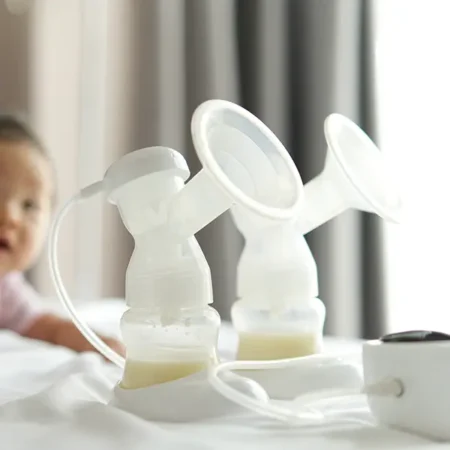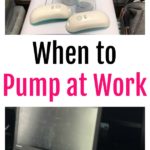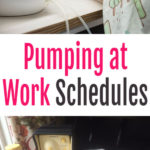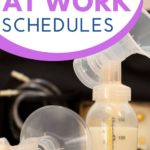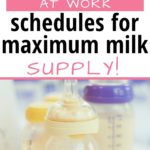Are you headed back to work and planning to pump breast milk for your baby? Not sure how often or how long you need to pump? Here’s what to consider when putting together your pumping at work schedule!
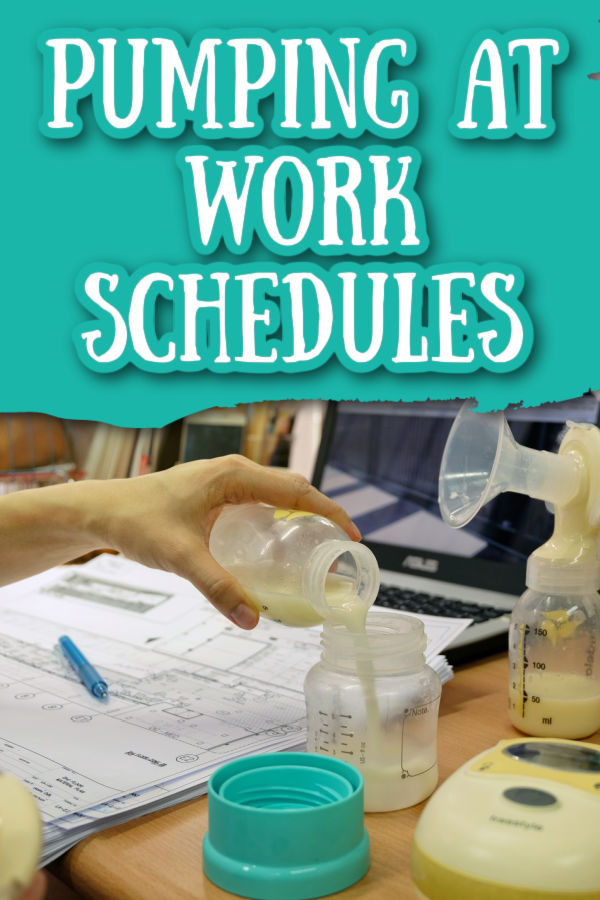
This post may contain affiliate links, which means that if you click a link and take action, I may make a small commission at no additional cost to you. I only recommend products I love! More info here.
What are your legal rights regarding pumping at work?
Before you start working out your schedule, it’s a good idea to understand what breaks your employer is required to provide.
In the United States, the Affordable Care Act includes a provision called Break Time for Nursing Mothers. This law was updated by the PUMP Act in 2022.
This provision requires employers to provide two things for employees that are covered by the law – a place to pump that is not a bathroom, and “reasonable” break time to pump. “Reasonable” is not defined, but some guidance is provided here.
Here is a lot more detail on pumping rights at work, including how to find the breastfeeding laws in your state.
How often should you pump at work?
The answer to this question can depending on your circumstances.
Things to consider
Here are the things to take into account when deciding how many times to pump at work.
- How long you are at work. Obviously, you’d need to pump more often during a 12 hour shift than an 8 hour shift.
- How old your baby is. You will want to pump more frequently with a younger baby.
- What you can realistically manage at work. Some jobs are harder to get pumping sessions in than others; it can be really difficult for a bus driver or server to take pumping breaks, especially if their employer isn’t legally required to provide them.
Suggested number of pumping sessions
Generally speaking, I would start by aiming for the below number of sessions based on how long you’ll be at work when you first go back:
- 4 hour workday: 1 pumping session
- 6 hour workday: 2 pumping sessions
- 8 hour workday: 3 pumping sessions
- 12 hour workday: 4 pumping sessions
However, just consider this a starting point to work from as you consider the other two factors (the age of your baby, and what you can manage).
For example, many breastfeeding employees in the United States go back to work when baby is 12 weeks old and start at 3 pumping sessions per day, then drop to two or even one as baby gets older and is eating more solid food.
If you are going back to work when baby is 9 months old, 3 sessions at work may not be necessary.
Or, maybe you work an 8 hour day, but don’t have any legal protections for pumping at work and are only able to pump once, on your lunch break. (We’ll talk about strategies for how to work with this below.)
How long should you pump at work?
This depends on how many pumping sessions you have.
If you are pumping the number of sessions I recommended above (based on length of your workday), then each pumping session should be about 15-20 minutes. In most cases, 15 minutes will be enough, but some people might need a little more time to “empty” their breasts.
(Obviously, you may need to cut one short every now and then to make a meeting or other obligation, but that is what I would aim for.)
If you are pumping less frequently, either because your baby is older or you are not able to due to your work schedule, your pumping sessions should be a bit longer.
How long?
In an 8 hour workday, I would aim for 40-60 minutes total pumping, if possible.
So, if you’re pumping twice during an 8 hour day, make each session 20-25 minutes long, if possible. If you’re pumping once, you may want to make it 40 minutes long.
I know sessions this long aren’t always feasible, so do the best you can. And obviously if your work day is longer or shorter, you’d want to adjust that total amount of time to reflect the time that you’re away from home.
Sample pumping at work schedules
Below are a few sample pumping schedules. (I’ll go more in detail on each of these, but wanted to give you something to screenshot for later in case it’s helpful.)

Please note that I’m only including the first pumping or nursing session before work, the pumping sessions at work, and the first pumping or nursing session after work in these schedules! You likely would pump or nurse again before bed and possibly at night, but there is a lot of variability in what each person needs.
Office worker with a 3 month old baby
I started out with a schedule very similar to this with each of my babies when I went back to work.
- 6AM-ish/Before work: Pump (exclusive pumpers) or nurse (nursing moms)
- 9AM: Pump for 15-20 minutes
- 12PM: Pump for 15-20 minutes
- 3PM: Pump for 15-20 minutes
- 6PM-ish/After work: Pump (exclusive pumpers) or nurse (nursing moms)
One thing to note: if you can pump WHILE you work, this can help save time. I work in an office and brought my laptop to the lactation room, and would answer emails or do other quick tasks while I pumped.
I would definitely suggest getting a hands-free pumping bra (you can read reviews of different options here) or a hands-free breast pump. It will make pumping at work so much easier.
(More on how to pump at work step by step here.)
Office worker with a 9 month old baby
Later, I transitioned to two sessions that were a bit longer.
- 6AM-ish/Before work: Pump (exclusive pumpers) or nurse (nursing moms)
- 10AM: Pump for 20-25 minutes
- 2PM: Pump for 20-25 minutes
- 6PM-ish/After work: Pump (exclusive pumpers) or nurse (nursing moms)
Teacher
Often teachers are limited to pumping during prep periods and at lunch. You might want to make one session a bit longer to make sure you get enough pumping time in. Here’s an example of how that might look:
- 7AM-ish/Before work: Pump (exclusive pumpers) or nurse (nursing moms)
- 11:30AM: Lunch. Pump for 30 minutes
- 2:00PM: Prep Period. Pump for 15-20 minutes
- 4:30PM-ish/After work: Pump (exclusive pumpers) or nurse (nursing moms)
Sometimes, a prep period can be right before or right after lunch, which can make getting multiple pumping sessions in during the school day difficult.
What I usually recommend in situations like this is pumping right before and after school (possibly during your commute), with either one long session during the combined prep/lunch period or two shorter ones (one at the beginning of it and one at the end). You can experiment and see what works best for you.
- 7AM-ish/Before work: Pump (exclusive pumpers) or nurse (nursing moms)
- 11AM: Prep Period. Pump for 20 minutes right at 11AM
- 11:40AM: Lunch. Pump for 20 minutes at the end of the lunch period (say, 12PM-12:20PM)
- 3:30PM-ish/After work: Pump (exclusive pumpers) or nurse (nursing moms)
Or:
- 7AM-ish/Before work: Pump (exclusive pumpers) or nurse (nursing moms)
- 11:30PM: Prep Period/Lunch. Pump for 35-40 minutes.
- 3:30PM-ish/After work: Pump (exclusive pumpers) or nurse (nursing moms)
Nurse
The below schedule is based on a 7AM to 7PM shift with two short breaks and a lunch break. If you have time where you sit down to do paperwork, that may also be time that you can pump with a hands-free setup to get a fourth session in.
- 6AM-ish/Before work: Pump (exclusive pumpers) or nurse (nursing moms)
- 9AM: First Break. Pump for 15-20 minutes
- 12PM: Lunch/Meal Break. Pump for 30 minutes
- 4PM: Second Break. Pump for 15-20 minutes
- 8PM-ish/After work: Pump (exclusive pumpers) or nurse (nursing moms)
Obviously, your breaks will often depend on patient needs. It’s okay to move times around if necessary.
If you have to skip a session, that’s fine, just try to make up the time later if possible.
Additionally, I know that some healthcare workers pump while seeing patients with using a Willow with their spill-proof bags (so you can bend over and care for patients without spilling any milk) and wanted to pass that along.
Strategies for pumping at work when you don’t get breaks
It can really be challenging when you aren’t entitled to breaks to pump at work. However, it doesn’t necessarily mean that you have to wean.

Here are a few strategies if you don’t get pumping breaks:
- Use a hands-free pump while you work. A hands-free pump like the Willow, Elvie, or Freemie Liberty are good options. (See photo above of a TSA agent pumping while working with a Freemie Liberty.)
- Pump as much as you can before and after work, on your commute if possible.
- Get a manual pump and use it to take the pressure off whenever you have 5 minutes or so.
More ideas on pumping at work without breaks here.
What if pumping takes too long?
One struggle that some have with pumping at work is that it takes too long.
It’s not uncommon to sit down to pump and find that it takes 5-10 minutes to get your breast milk to let down. This is especially common for nursing moms, because they are used to having their baby there to trigger the letdown reflex. (More on how letdowns work here.)
Some options for speeding things up if this is the case for you:
- Try a warm compress (you can put Booby Tubes in the microwave, which might help)
- Try replacing your breast pump parts if it’s been a while
- Try a lactation massager* – the combined heat and vibration helps speed things up for some women
- If you are a nursing mom, try looking at a photo or video of your baby
(*Note: LaVie makes two lactation massagers – a smaller one with just vibration and a warming massager that has heat AND vibration. They are both super helpful – use the code EPUMP on their website for 10% off!)
More information on how to pump faster here.
What is your pumping at work schedule like? What have you tried that’s worked for you, and what hasn’t?
Nervous about pumping at work? Want help building your freezer stash, creating a packing checklist, and putting together a pumping schedule? Check out my Ultimate Pumping at Work Workbook here! Use EPUMP30 for 30% off.
